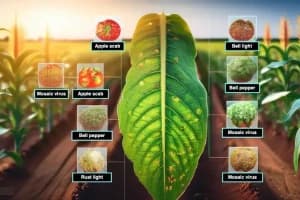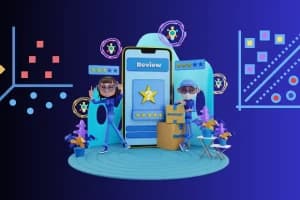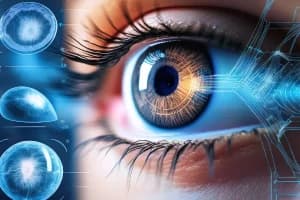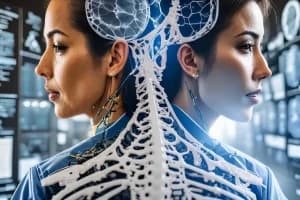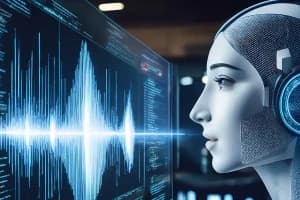The field of Generative AI is exploding. Just look at tools like ChatGPT, Midjourney, and GitHub Copilot, which hint at what happens when machines start creating text-and-image content, code, and much more. But that is only a scratch on the surface; if you are a developer, entrepreneur, or creative mind, this is your opportunity to ride the wave.
Here are 25+ best generative AI projects ideas a developer can explore, experiment with, or turn into a real product-from practical tools to experimental ideas.
1. Voice Cloning Application Using RVC
Overview: Develop an application that can replicate a person's voice by learning from a few audio samples. This involves training a model to generate speech that closely matches the target voice's tone and style.
Skills Needed:
- Python Programming
- Google Colab
- Deep Learning
- Audio Processing (Librosa, PyDub)
- RVC for Voice Cloning
- Audio Formats (WAV/MP3)
Resource Link: Voice Cloning Application Using RVC
2. Chatbots with Generative AI Models
Overview: This generative AI project develops chatbots that use generative AI models for managing flexible user conversations. Through the application of modern NLP techniques, the chatbot produces responses that sound natural to people, enabling it to interact across multiple types of dialogue. The model showcases its practical application in functional systems such as customer support services and personal assistance as well as interactive platforms.
Skills Needed:
- Python Programming
- API Integration (OpenAI API)
- Generative AI Models (GPT-3.5, GPT-4)
- Google Colab
- Chatbot Development
Resource Link: Chatbots with Generative AI Models
3. Customer Service Chatbot Using LLMs
Overview: The project demonstrates the creation of an LLM-based customer service chatbot, which forms the central focus. The system uses retrieval-based methods together with conversational AI to generate exact context-specific answers that satisfy customer inquiries. This system provides a solution that handles varied queries through knowledge base grounding, which makes it suitable for practical support operations.
Skills Needed:
- Python
- LangChain
- NLP libraries
- LLM fine-tuning (GPT-4, Llama 3)
- API integration (OpenAI, Anthropic)
- REST API
- Vector databases (FAISS, Chroma)
- Sentiment analysis for customer interactions
- Multilingual NLP processing
Resource Link: Customer Service Chatbot Using LLMs
4. Paraphraser: Sentence Paraphrase Generation
Overview: The paraphraser project enables users to generate paraphrases of sentences through a straightforward API. Developed during the Insight Data Science Artificial Intelligence program, it utilizes a bidirectional LSTM encoder and LSTM decoder with attention mechanisms, implemented using TensorFlow. A live demo is available at pair-a-phrase.
Skills Needed:
- Python,
- NLP,
- Machine learning.
- TensorFlow 1.4.1,
- spaCy
Resource Link: Paraphraser
5. RAG using Llama 2, Langchain, and ChromaDB
Overview: This notebook demonstrates building a Retrieval Augmented Generation (RAG) system using Llama 2.0, Langchain, and ChromaDB. It showcases how to integrate external data sources with large language models (LLMs) to improve response accuracy and relevance.
Skills Needed:
- Llama 2.0
- Langchain
- ChromaDB
- RAG
Resource Link: RAG using Llama 2, Langchain, and ChromaDB
6. HyDE-Powered Document Retrieval Using DeepSeek
Overview: This project demonstrates the development of an intelligent document retrieval system by integrating technologies such as FAISS, DeepSeek, LangChain, and HuggingFace. The system efficiently processes and stores PDF documents, enabling rapid and accurate retrieval of relevant information in response to user queries.
Skills Needed:
- Python,
- LangChain
- HuggingFace Transformers:
- FAISS
- DeepSeek
Resource Link: HyDE-Powered Document Retrieval
7. LLM Detect: AI-Generated Text Detection
Overview: The Kaggle competition titled "LLM - Detect AI-Generated Text" challenges participants to develop machine learning models that distinguish between student essays and those generated by large language models (LLMs). The dataset comprises over 28,000 essays, including both student-authored and LLM-generated texts, providing a substantial foundation for model training and evaluation.
Skills Needed:
- Machine Learning
- Natural Language Processing (NLP)
- Data Preprocessing
- Model Evaluation
- Python Programming
- Feature Engineering
Resource Link: AI-Generated Text Detection
8. Nutritionist Generative AI Doctor Using Gemini
Overview: The "Nutritionist Generative AI Doctor using Gemini" project leverages Google's Gemini AI model to analyze food images and provide detailed nutritional insights. By simply uploading a meal photo, users receive information on calorie content, macronutrient distribution, and micronutrient details, facilitating informed dietary choices.
Skills Needed:
- Python Programming
- Google Colab
- Google Gemini AI
- API Integration
- Image Processing (Pillow)
- Data Analysis
Resource Link: Nutritionist AI with Gemini
9. Building RAG Using Gemma and FAISS Vector DB
Overview: A practical example of making a Retrieval-Augmented Generation (RAG) system uses Gemma language models from Google along with FAISS vector databases. The implementation provides a complete end-to-end framework that produces question-answering systems through the combination of relevant information retrieval and generative features. Document processing, along with vector embedding generation and efficient similarity search, and context-aware response generation, form part of the project development.
Skills Needed:
- Python,
- Natural Language Processing (NLP),
- Retrieval-Augmented Generation,
- FAISS,
- Gemma (Google's Open LLM),
- Hugging Face Transformers
Resource Link: Building RAG using Gemma + FAISS Vector DB
10. Optimizing Chunk Sizes for Efficient and Accurate Document Retrieval Using HyDE Evaluation
Overview: The project investigates how appropriate chunk size optimization enhances both the operational speed and precision of document retrieval systems. HyDE evaluation methods serve to find the best chunking strategy as part of testing different chunk sizes for enhanced semantic search effectiveness. The study delivers functional knowledge that improves the performance of RAG and question-answering systems.
Skills Needed:
- Python,
- Natural Language Processing (NLP),
- Retrieval-Augmented Generation,
- FAISS,
- Gemma (Google's Open LLM),
- Hugging Face Transformers
Resource Link: Building RAG using Gemma + FAISS Vector DB
11. Corrective Retrieval-Augmented Generation (RAG) with Dynamic Adjustments
Overview: A Corrective Retrieval-Augmented Generation (RAG) system operates within this project framework to modify its retrieval sequences by accepting input from generation feedback. The system enhances the precision of retrieved context during real-time operations to generate more accurate answers. An innovative solution for RAG pipeline optimization exists in this implementation through adaptable retrieval methods.
Skills Needed:
- Python,
- Retrieval-Augmented Generation (RAG),
- LangChain,
- Prompt Engineering,
- Dynamic Retrieval Techniques,
- Embedding Models
Resource Link: Corrective Retrieval-Augmented Generation (RAG) with Dynamic Adjustments
12. Enhancing Document Retrieval with Contextual Overlapping Windows
Overview: Document retrieval performance receives an enhancement through the application of contextual overlapping windows in this research study. Text chunk overlapping performed during preprocessing maintains document context, which produces better coherence and accuracy in tasks such as question answering. The analytic process suits documents that require extensive semantic continuity throughout their length.
Skills Needed:
- Python programming
- Text processing (tokenization, chunking, windowing)
- Contextual embedding models
- Overlapping window techniques for document segmentation
- Vector databases
- Semantic search and retrieval methods
- Document indexing and storage optimization
- NLP libraries (spaCy, NLTK, Hugging Face Transformers)
Resource Link: Enhancing Document Retrieval with Contextual Overlapping Windows
13. Document Augmentation through Question Generation for Enhanced Retrieval
Overview: The project shows that automatic question generation as a document enhancement method produces substantial increases in retrieval success. The system enhances its retrieval capability during query time by creating potential questions from source documents that expand knowledge base information. The method provides a useful solution to enhance RAG performance within Question Answering systems.
Skills Needed:
- Python programming
- LangChain framework
- Vector databases (FAISS, Chroma)
- OpenAI API (GPT-4o)
- PDF processing (PyPDF2) for text extraction
- Embedding models (Sentence Transformers, OpenAI)
- Semantic search and retrieval techniques
Resource Link: Document Augmentation through Question Generation for Enhanced Retrieval
14. Context Enrichment Window Around Chunks Using LlamaIndex
Overview: LlamaIndex uses context windows to enhance document retrieval performance, which is the primary focus of this project. The semantic relevance in retrieval operations and question answering is strengthened through the intelligent expansion of context windows applied during indexing. This approach links individual chunks to the overall meaning of the document, ultimately producing improved RAG results.
Skills Needed:
- Python programming
- LlamaIndex,
- Context Windowing,
- Information Retrieval,
- Chunk Optimization
Resource Link: Graph-Enhanced Retrieval-Augmented Generation (Graph-RAG)
15. Graph-Enhanced Retrieval-Augmented Generation (GRAPH-RAG)
Overview: The work introduces Graph-Enhanced Retrieval-Augmented Generation (Graph-RAG) through which knowledge graphs enhance the RAG pipeline to maintain context coherence and relevant connections. The system can access better generation outputs through its ability to retrieve information based on concept relationships drawn as graphs. Users can benefit from this approach when addressing queries that need multiple steps to answer.
Skills Needed:
- Python,
- Knowledge Graphs,
- Retrieval-Augmented Generation (RAG),
- Graph-Based Retrieval,
- Natural Language Processing (NLP),
- LlamaIndex
Resource Link: Graph-Enhanced Retrieval-Augmented Generation (GRAPH-RAG)
16. Fusion Retrieval: Combining Vector Search and BM25 for Enhanced Document Retrieval
Overview: To improve search results, the project combines FAISS vector embedding semantic search with keyword-based BM25 ranking. The method collects PDF text and splits it into segments to create embeddings using Hugging Face's MiniLM model. FAISS handles semantic similarity parameters while BM25 handles keyword relevance functions and blends outputs for simultaneous retrieval. Hypothetical document production utilizing DeepSeek-R1-Distill-Qwen-1.5B LLM refines outcomes through contextual knowledge.
Skills Needed:
- Python
- NLP & Text Processing
- Vector Search (FAISS, Sentence Transformers)
- Keyword Retrieval
- Hybrid Fusion
- LLM Integration
Resource Link: Fusion Retrieval: Combining Vector Search and BM25 for Enhanced Document Retrieval
17. Fusion Retrieval: Combining Vector Search and BM25 for Enhanced Document Retrieval
Overview: To improve search results, the project combines FAISS vector embedding semantic search with keyword-based BM25 ranking. The method collects PDF text and splits it into segments to create embeddings using Hugging Face's MiniLM model. FAISS handles semantic similarity parameters while BM25 handles keyword relevance functions and blends outputs for simultaneous retrieval. Hypothetical document production utilizing DeepSeek-R1-Distill-Qwen-1.5B LLM refines outcomes through contextual knowledge.
Skills Needed:
- Python
- NLP & Text Processing
- Vector Search (FAISS, Sentence Transformers)
- Keyword Retrieval
- Hybrid Fusion
- LLM Integration
Resource Link: Fusion Retrieval: Combining Vector Search and BM25 for Enhanced Document Retrieval
18. Multi-Modal Retrieval-Augmented Generation (RAG) with Text and Image Processing
Overview: The proposed system develops a multi-modal RAG system that utilizes text and image processing for improved search functions alongside generation capabilities. The system employs visual-text embedding models CLIP/BLIP together with FAISS/Chroma for storage, which lets users execute searches like "Find documents that match similar images, followed by their summary. The system integrates three primary capabilities through cross-modal search and joint text-image processing and multi-modal LLM response functions (GPT-4V/LLaVA and others).
Skills Needed:
- Python programming
- Multi-modal models
- Vector databases (FAISS, ChromaDB)
- Image processing
- Text embedding models
- LLM integration
- Cross-modal retrieval techniques
- Document processing
- Multi-modal embeddings generation
Resource Link: Multi-Modal Retrieval-Augmented Generation (RAG) with Text and Image Processing
19. Stable Diffusion: Latent Text-to-Image Generation Model
Overview: The advanced text-to-image diffusion model Stable Diffusion was established by CompVis to create detailed image outputs from user-provided text instructions. Through operation in a compressed latent space, a deep learning architecture enables efficient image generation but maintains excellent generation quality. Users utilize Stable Diffusion as an established tool for digital art creation, and they use it to generate content for various applications. Large quantities of paired images alongside text are used to train this system, which applies the integration of both CLIP and UNet techniques to produce images that fulfill the given descriptive requirements.
Skills Needed:
- Python,
- Deep Learning,
- Generative Models,
- Diffusion Models,
- TensorFlow/PyTorch,
- Natural Language Processing (NLP),
- Image Generation,
- Computer Vision,
- Model Fine-Tuning
Resource Link: Stable Diffusion
20. Image Colorization using Autoencoder
Overview: The Kaggle notebook details how autoencoders perform the conversion of black and white photos into color images. Autoencoders function as neural networks that train their data reconstruction while discovering efficient data representations during learning. The autoencoder trains to convert grayscale pictures to their corresponding color presentations through this project. The available dataset includes landscape images, which can be used for model training and evaluation because they contain both color and grayscale variations.
Skills Needed:
- Python
- Deep Learning with Keras
- Autoencoders
- Image Processing
- Neural Network Training
- Model Fine-Tuning and Evaluation
Resource Link: Image Colorization using Autoencoder
21. PyTorch-GAN: Implementations of Generative Adversarial Networks
Overview: PyTorch-GAN is a repository that offers PyTorch implementations of various Generative Adversarial Network (GAN) architectures. The collection includes models such as Auxiliary Classifier GAN, Adversarial Autoencoder, BEGAN, and many others. The implementations aim to capture the core ideas of each GAN variant, providing a practical resource for understanding and experimenting with different GAN architectures. While the model architectures may not always mirror the original papers exactly, the focus is on conveying the fundamental concepts effectively.
Skills Needed:
- Python programming (v3.6+)
- PyTorch framework (GAN implementation, autograd, custom layers)
- Deep Learning (GAN architectures, CNNs, training loops)
- Generative Adversarial Networks (DCGAN, WGAN, CycleGAN, etc.)
- Neural Network optimization (loss functions, hyperparameter tuning)
- GPU acceleration (CUDA, cuDNN)
- Image processing (OpenCV, PIL)
- Data pipelines (Dataset/Dataloader in PyTorch)
- Model evaluation (FID, Inception Score, visual assessment)
Resource Link: PyTorch-GAN
22. Generative AI: A Renaissance in Creativity
Overview: A Kaggle notebook investigates how Generative Artificial Intelligence (AI) modifies creative work creation through various sectors. The paper discusses the transformation of art music and literature as Generative AI models, including GANs and large language models, empower machines to create realistic humanlike artistic works. The notebook presents information about how these models work and displays their abilities, and explains how AI content generation affects traditional definitions of both creativity and authorship.
Skills Needed:
- Python programming
- Generative AI models (GPT, DALL·E, Stable Diffusion)
- Transformers & LLMs (Hugging Face, OpenAI API)
- Deep Learning frameworks (PyTorch, TensorFlow)
- Neural text generation (GPT-3/4, Claude)
- Image generation (Diffusion models, GANs)
- Prompt engineering
Resource Link: Generative AI: A Renaissance in Creativity
23. POINT-E
Overview: Point-E by OpenAI operates as a 3D point cloud generator that transforms both text commands and images into 3D results during 1-2 minutes by executing two separate diffusion steps, beginning with text-to-image synthesis and ending with 3D point cloud generation using a single GPU. With a subpar output standard compared to other methods, it stays quick enough to serve as a useful tool in rapid prototyping and education systems, and Blender mesh conversion processes.
Skills Needed:
- Python (v3.7+) for pipeline scripting
- PyTorch for model implementation
- Diffusion models (text-to-image & point cloud generation)
- 3D data processing (point clouds, meshes)
- GPU acceleration (CUDA)
- Blender (for mesh rendering)
- APIs (OpenAI integrations)
- Evaluation metrics (P-FID, P-IS)
Resource Link: Point-E
24. textgenrnn: Easy Training of Text-Generating Neural Networks
Overview: textgenrnn enables Python developers to simplify neural network training for text generation through its foundation, which combines TensorFlow and Keras frameworks. Users can establish models that produce text content at word and character levels through this platform. The module provides users with options to configure RNN dimensions together with RNN layer count alongside special capabilities for training models on personalized text databases. Users can find pre-trained models ready for text generation abilities.
Skills Needed:
- Python
- Deep Learning with Keras and TensorFlow
- Recurrent Neural Networks (RNNs)
- Text Generation Techniques
- Natural Language Processing (NLP)
Resource Link: textgnrnn
25. PyTorch examples repository.
Overview: Fast Neural Style Transfer appears in the PyTorch examples repository through its implementation method for instant artistic style transformation of images. A feed-forward convolutional neural network (CNN) takes part in this method which trains for content image transformation into reference image styles. This technique provides efficient processing speeds suitable for practical applications because of its speed in attributing artistic styles to images.
Skills Needed:
- Python programming (v3.6+)
- PyTorch framework (autograd, custom layers, model training)
- Convolutional Neural Networks (CNNs) (VGG, ResNet architectures)
- Neural Style Transfer (NST) algorithms
- Image processing (OpenCV, PIL, torchvision transforms)
- GPU acceleration (CUDA, cuDNN)
- Model optimization (loss functions, hyperparameter tuning)
- Transfer learning
Resource Link: PyTorch examples repository
26. Poem Generation using GPT-2 with Keras NLP
Overview: A Kaggle notebook presents an application of GPT-2 which is a transformer-based language model for poetry generation. Through the utilization of KerasNLP, which operates as a TensorFlow-based high-level NLP library, users can see how to modify GPT-2 using a poetry dataset to generate of coherent, creative poetic content. Data preprocessing combined with model customization and generation techniques enables the improvement of generated poetic output throughout the process.
Skills Needed:
- Python
- Deep Learning with TensorFlow and Keras
- Natural Language Processing (NLP)
- Transformer Models, specifically GPT-2
- Text Generation Techniques
- Model Fine-Tuning and Evaluation
Resource Link: Poem Generation using GPT-2 with Keras NLP
Conclusion
Generative AI is reshaping the boundaries of creativity, technology, and innovation, offering endless possibilities for developers, entrepreneurs, and creators alike. From crafting voice cloning applications with RVC to building intelligent document retrieval systems using RAG and LLMs, the 25+ AI project ideas outlined above provide a launchpad for exploring this dynamic field. Whether you're enhancing customer service with chatbots, generating art with Stable Diffusion, or pioneering multi-modal systems, these projects blend cutting-edge tools like Python, PyTorch, and Hugging Face with real-world applications. The resources linked to each idea-ranging from Kaggle notebooks to GitHub repositories-equip you with the starting points to experiment, innovate, and even productize your creations. Dive into these best generative AI projects ideas, hone your skills, and ride the wave of this transformative technology to turn your ideas into reality.

